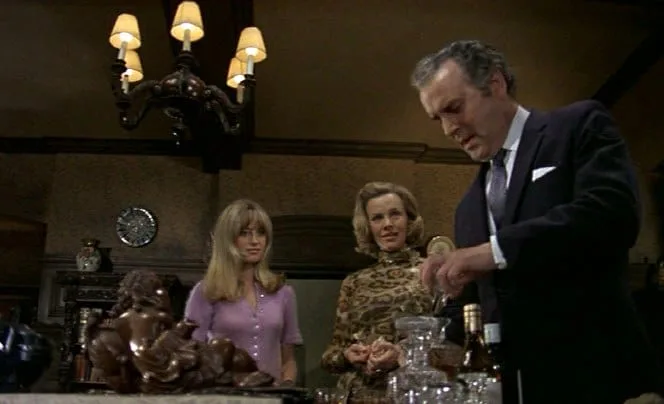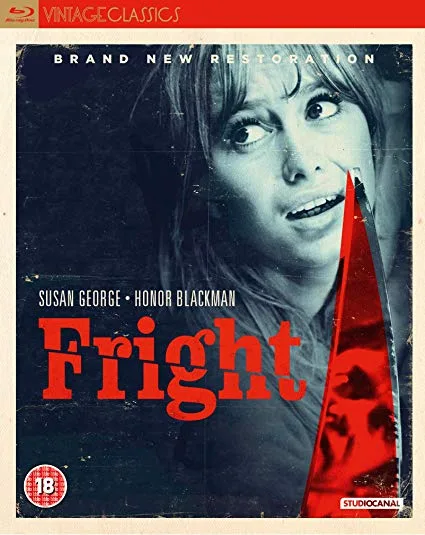
Whilst the whole ‘terrified babysitter’ shtick is nothing new in horror cinema, its use and development in Fright (not far off fifty years ago now) is just one facet of the way in which the film works quite differently to a lot of its contemporaries, as well as the films which have followed in its wake. Fright deals in threats and intimations, rather than great amounts of violence or bloodshed. In this respect, it’s a very effective film which creates a great deal of atmosphere.
From the opening scenes of babysitter Amanda (Susan George) arriving at the rather remote house where she’ll be working that evening, you get the sense of something inauspicious waiting in the wings. Add to this the incredibly nervous behaviour of mother Helen Lloyd (Honor Blackman) as she checks and double-checks the locks, and you get the distinct early impression that things are not quite as they seem here – that this goes beyond a mother unused to leaving her three year old son at home. Still, it’s a rare night out, and husband Jim (George Cole!) urges her to get going; Amanda says everything will be fine and there’s nothing to worry about. However, as soon as they’re in the car, the couple discuss whether or not Amanda ‘knows’ the real circumstances of their celebration. It’s a small village, after all. It seems that Amanda’s guess that they’re celebrating an anniversary is not entirely accurate…
Amanda settles in for the night, but an unexpected face at the door startles her; shortly after, her sometime boyfriend Chris (Dennis Waterman) appears, and makes it pretty clear he’s come round with the express purpose of sleeping with her, though he gets short shrift. He says it wasn’t him looking through the window though; he’s also able to give Amanda some local information about the Lloyds, telling her that Helen does in fact have a husband, who had been incarcerated for trying to kill her. The stage, then, is set. We know why Helen is so anxious, and we know who might very well be about to turn up.

Whilst the Chris explication is a little overly convenient, the film does take this aspect of the plot and do interesting things with it. For example, the endlessly panning camera as Amanda moves around the property does create a sense of unease for the audience; actually, from the moment the camera first finds her, as she gets off the bus and walks down to the house, the film is excellent at creating a sense of her vulnerability, so her instant fear as she hears Chris’s story works pretty well. Even before this, every noise in the house takes on a resonance; we’re clearly primed for an ordeal before any ordeal takes place, and it’s all economically done. Other things are nicely handled, too, such as the inclusion of a horror film within this horror film. As Amanda tries to immerse herself in what’s on the TV, the fantasy horror of Plague of the Zombies, she misses the very real threat at her door. Again, it’s subtly done, but it works in terms of developing interest. The systems which are meant to be put in place to help her (such as the police) are represented as stultified and inept, too, which builds frustration on Amanda’s part and allows the threat against her to progress.
Despite all of that build-up, Fright is perhaps surprisingly low on actual violence; its escalation is in terms of human emotions, far more than it is in physical harm (although there is some). This means that, interestingly, Amanda and Helen’s characters are presented as two sides of the same coin in key respects, and indeed one of the characters sees them interchangeably, with the film helpfully representing this to us by swapping them, showing Amanda as she appears as Helen. Amanda quickly understands this mania, using the survival instinct women often have to play along and placate, though all while enacting very plausible terror at her situation.
Fright is very good at projecting a steady, yet sustained kind of horror, from the perspective of the panic of two women, and how they try to protect themselves and those dear to them in dire circumstances. Yes, there are a couple of abrupt sequences (such as the ending itself) but overall, good performances and a palpable atmosphere help to get the most out of what on paper would seem a very straightforward, tried-and-tested story. This Studiocanal release looks great and you would never believe this film was nearly half a century old; you can find out more about their edition here.
